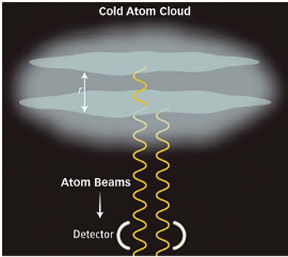- More than 2 years ago
Physicists have had their first look at how matter transitions into an exotic state known as a Bose-Einstein condensate—an ultracold fluid that displays quantum behavior.

The atoms in a Bose-Einstein condensate share a collective quantum persona that has wave properties at macroscopic scales and can show patterns of interference, just as waves on a pond do. Because the behavior of condensates theoretically can be tuned to simulate the quantum properties of other states of matter, physicists expect to use the condensates to investigate poorly understood phenomena such as high-temperature superconductivity.
Turning a gas into a Bose-Einstein condensate requires confining it in a magnetic field and chilling it to near absolute zero. Theory predicts that the new state will not appear abruptly. Instead, starting just above the critical temperature, bubbles of condensate will fleetingly form and disappear, increasing in size as the temperature falls. At the critical temperature, the bubbles will merge and the entire system will become a condensate.
Physicists apply the word criticality to the phenomenon in which a wide class of transitions has that gradual behavior. For example, a hot metal cooling in a magnetic field becomes a permanent magnet in a similar fashion. Until now, no one had precisely documented the criticality of Bose-Einstein transitions.
In the new experiment, described in the March 16 Science, physicists at the Swiss Federal Institute of Technology in Zurich and the University of Cambridge in England magnetically confined a Bose-Einstein condensate of rubidium atoms and let it spontaneously warm, crossing the critical temperature in reverse. The team went to great lengths to keep heat from leaking into its condensate too quickly. In the setup, temperature rose by only 4 billionths of a kelvin per second.
To probe the condensate as it slowly transitioned into a regular gas slightly warmer than the critical temperature, the physicists switched off the confining magnetic field at two heights within the condensate. Freed atoms at those locations dropped into a detector instead of flying off randomly. The atoms have so little motion that they “fall like a rock,” says team member Michael Köhl, now at Cambridge.
Inside the detector, which can count single atoms, the two overlapping streams of atoms sometimes interfered like waves—for example, canceling each other out so that the detector saw nothing. That could happen only if the atoms had the same quantum state, so they must have come from within the same bubble of condensate. By varying the distance between the two test locations, the physicists estimated the typical size of the bubbles at any given temperature.
As expected, that size shrank as temperature increased, at a pace consistent with what’s known about similar quantum systems such as superfluid helium, Köhl says. “People have looked at either side of the critical temperature, but not at the transition, with this accuracy,” he adds.
“Until now, no one thought these experiments could be used to measure critical behavior,” says Eugene Demler of Harvard University. He says that the technique opens new possibilities for studying not only Bose-Einstein condensates but also general properties of criticality.







